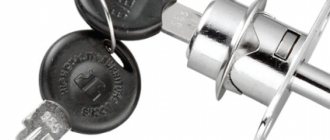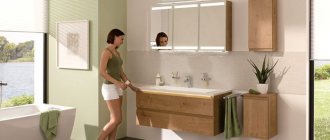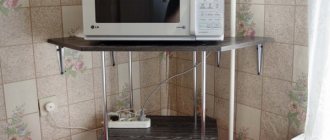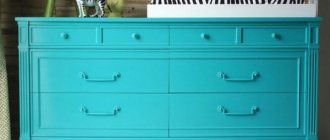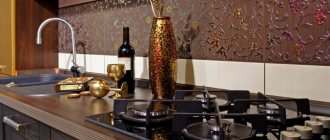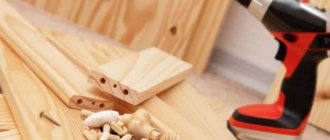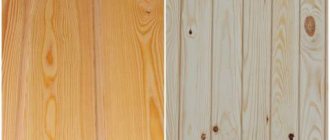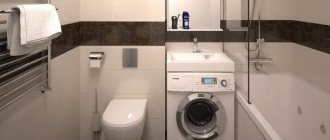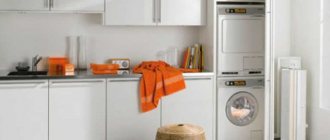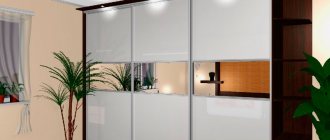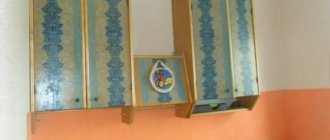Types and types of locks
The design of a furniture lock is determined by the material on which it is installed.
This is explained by the fact that the lock is designed for a certain thickness of the door or drawer front and a different method of fastening (for example, you cannot screw a self-tapping screw into glass). Castles are divided into:
- furniture locks for chipboard and wood (as a rule, designed for a thickness of 16-18 mm) When attaching furniture locks to chipboard and wood, practically no problems arise: a hole is drilled for the cylinder, and the lock body is attached on the reverse side. On the outside, the hole for the larva can be decorated with decorative overlays.
- furniture locks for glass (usually glass with a thickness of 5-6 mm is used, rarely 8 mm) Locks for glass are universal; glass of any thickness used can be secured in them. They are also suitable for metal (e.g. metal cabinets, mailboxes). Glass locks come in mortise locks (requiring glass drilling) and overhead locks. The difficulty of installing mortise locks is that not every manufacturer has the ability to drill glass well and accurately install a lock in these holes. Thus, drilling requires a special machine with drills for diamond-coated glass, drilling glass from both sides at the same time. In this case, a cooling emulsion should be supplied, which makes the process better. Such a machine costs from 5 thousand EUROS.
Therefore, rim locks are most often used for glass doors, for the installation of which it is not necessary to drill the glass. These locks have an “L-shaped bar” that fits over the glass. Screws are inserted into the holes in the bar and the lock is pressed against the glass through a plastic spacer.
Locks also vary depending on what they are for: drawers, sliding doors, or hinged doors. Locks for swing doors are divided into locks for one door and for double doors.
In addition, locks differ in the principle of operation of the mechanism: with a retractable tongue, rotary, push-button, harpoon-shaped, rack and pinion with a locking mechanism.
The designs and mechanisms of operation of locks in most manufacturing countries are very similar, so we will focus on the main models that are a priority for the Russian market.
Product Features
Furniture locks are included in the basic package of many sets and are installed at the factory during the assembly process. The traditional design is a conventional locking mechanism equipped with a tongue, a key and other necessary elements. The main purpose of the part is to keep the doors tightly closed. If necessary, you can install this element on finished furniture, where the presence of locks was not originally designed.
The main feature that furniture locks have is their size. Compared to conventional designs, they are reduced several times. This allows for hidden installation and maximum hiding of locking mechanisms.
Furniture locks are used on various items, doors or drawer linings. The following designs exist:
- Button lock. Used for sliding wardrobe doors. To close it, you need to press the lock cylinder (or lock cylinder). Unlocks with a key - 2 pieces included.
- Rack and pinion. Used for fixing glass sliding sashes. This group also includes a latch version, which is installed on hinged doors in a horizontal position.
- With latch. Its design is closest to conventional locking mechanisms. Used for installation on hinged doors of cabinets or on drawer linings. Locks itself, opens with a key (2 pieces included).
- Overlay for glass sashes. There are models for single and double door cabinets.
Tips for choosing wheels for furniture and rules for calculating loads
Button lock
Rack and pinion
With latch
Invoice
Different materials are used for production:
- steel;
- aluminum;
- metal alloys;
- plastic.
The most preferred are steel devices, which are durable and reliable. Depending on the type of finish, there are gold, silver, and blackened products. The selection of a suitable model is carried out taking into account the type of design of the element and the design style of the headset. A lock in furniture should not only fulfill its direct tasks, but also provide decorative design, decorate the doors or linings of various products.
Steel
Aluminum
Metal alloys
Plastic
Lock manufacturers
On the Russian market you can find furniture locks from a variety of countries. But the most common are locks made in China, Taiwan, Italy, Germany and Austria. There are also locks of domestic production, but, as a rule, they are of the simplest designs.
Taiwanese locks were among the first to appear in Russia; the products are of fairly high quality and occupy an average price niche (on average, the price of one lock is 1.5-3 USD).
But the domestic market demanded cheaper locks, which was the reason for the appearance of Chinese products. Chinese locks basically copy the designs of Taiwanese locks, but are in a completely different niche, both in quality and price. It is almost impossible to predict how long a Chinese-made lock will last. Nevertheless, these locks are in steady demand, since for many domestic manufacturers the issue of their low cost is a priority.
At the same time, lately there has been interest in expensive accessories. This is how Italian locks appeared on the market. As for countries such as Austria and Germany, their products are distinguished by the highest quality at a consistently high price. The consumption of such locks in Russia is more individual than mass.
High-tech models
In addition to traditional options operating on a mechanical principle, there are more modern high-tech models. Among them there are the following varieties:
- Coded. There are electronic and mechanical versions. They work on the principle of typing a specific sequence of characters using a keyboard or rotary rollers. In addition, this product may have a magnetic key. The peculiarity of this model is the large number of options for digital combinations. One of them is the key. The advantage of this design is the ability to find the desired combination by selecting options. If you go through the combinations for a long time, sooner or later the desired sequence of numbers will be found. This feature comes in handy when a combination is forgotten or lost. The disadvantage is that they are quite large in size, which complicates installation and can ruin the appearance of the furniture.
- Electromagnetic lock. Driven by power supply. A strong magnetic field is generated, retracting the latch and allowing the door to open. It locks in the usual way, like any spring type. Installation consists of attaching the mechanism itself and connecting the power wire to the electromagnet. The advantage of such locks is that it is impossible to pick up a master key, as well as their resistance to corrosion. Users note durability and ease of installation. The disadvantage is that it stops working when there is a power outage. The situation can be corrected by using a backup power source.
- Electromechanical. It is a set of a lock mechanism, a power source and a control unit. If there is a sudden power outage, programming failures are often observed, which requires reconfiguring the system. This procedure is not particularly difficult. Disadvantages are sensitivity to moisture and tendency to form condensation. Not suitable for installation in areas with high humidity, such as a bathroom.
- Electronic. One of the most modern, advanced models. The key to such locks is digital cards or chips. Installation first requires the installation of a mechanical drive, then the connection of an electronic recognition system. The advantage is the absence of a regular key and the impossibility of counterfeiting a chip or card. In this case, the code combination is quickly changed if necessary. The electronic lock is sensitive to temperature changes, power surges, and short-lived.
Advantages of larch furniture board, its varieties
Each furniture lock has one degree or another of reliability. The most burglar-resistant types of locking mechanisms are: electronic, coded, and mortise lever.
Modern models are usually used for office furniture. At home, they are inappropriate and spoil the appearance of the headset.
Code
Electromagnetic
Electromechanical
Electronic
Finishing touch
The service life of a lock depends, first of all, on its quality: the better it is assembled, the stronger the material, the longer the lock will last. Good locks, in addition, should not change their color or fade, that is, they should have a high-quality coating.
Also, when purchasing a lock, you should pay attention to how smoothly the mechanism works, and most importantly, the key from one lock should not fit another. Manufacturers of quality locks have thousands of different combinations to avoid this situation.
You can familiarize yourself with all of the above lock models in more detail in the electronic catalog or at the MDM office, where professional managers will show you each model in action and choose the best option for you.
Come and choose “Locks worthy of your furniture”!
How to install it yourself
Installing a furniture lock will be quite feasible for most users. The greatest difficulty is the installation of a mortise structure. Procedure:
- The necessary tools are being prepared. You will need an electric drill, a Forstner drill or a pen drill (the first is better), a ruler, an awl, and a screwdriver.
- Marking is being done. Usually a diagram is attached to the lock, which is placed on the door and the centers of all holes are marked. If there is no diagram, you need to accurately determine the dimensions and mark the drilling points on the sash. They are marked with an awl to leave indentations for centering the tool.
- The necessary holes are made. As a rule, you need a through one for the mechanism and several blind ones for fasteners, although there may be other options.
- The lock is fixed, a decorative ring is put on the cylinder.
- Next, focusing on the position of the part, the installation location of the counter structure is noted. It is attached to a fixed part of a cabinet or table.
Purpose and types of furniture hinges, installation nuances
The last step will be to check the functionality of the product and adjust the response bracket, if necessary. As a rule, you need to slightly bend the corner to achieve the desired result. After this, the installation is considered complete, and normal operation of the lock begins.
Tools are being prepared
Marking is being done
Holes are drilled
The lock is fixed
A counter structure is being installed
